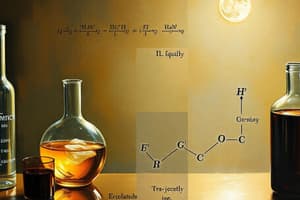Podcast
Questions and Answers
What is chemistry?
What is chemistry?
The branch of science that deals with the composition, properties, and behavior of various substances and the processes that change them.
Define a chemical reaction.
Define a chemical reaction.
A process that leads to the transformation of one set of chemical substances to another, involving the rearrangement of atoms in a substance resulting in the formation of new compounds.
What are synthesis reactions?
What are synthesis reactions?
Synthesis reactions result in the formation of a larger molecule from two or more smaller molecules.
What are decomposition reactions?
What are decomposition reactions?
What are single displacement reactions?
What are single displacement reactions?
What is the balanced chemical equation for the reaction between sodium chloride and silver nitrate?
What is the balanced chemical equation for the reaction between sodium chloride and silver nitrate?
Define a double displacement reaction.
Define a double displacement reaction.
Classify the following as a strong acid or weak acid: acetic acid
Classify the following as a strong acid or weak acid: acetic acid
What is the stoichiometry of a chemical reaction?
What is the stoichiometry of a chemical reaction?
What are the products formed in the reaction between zinc and copper sulfate?
What are the products formed in the reaction between zinc and copper sulfate?
Flashcards are hidden until you start studying
Study Notes
Chapter 1: Chemistry Class 10
Introduction to Chemistry
Chemistry is the branch of science that deals with the composition, properties, and behavior of various substances and the processes that change them. The study of chemistry helps us understand the world around us, from the subatomic particles that make up everything to the vastness of the universe.
Chemical Reactions
A chemical reaction is a process that leads to the transformation of one set of chemical substances to another. It involves the rearrangement of atoms in a substance, resulting in the formation of new compounds. Chemical reactions can be either synthesis or decomposition reactions.
Synthesis Reactions
Synthesis reactions, also known as combination reactions, result in the formation of a larger molecule from two or more smaller molecules. For example, the reaction between hydrogen gas and oxygen gas to form water is a synthesis reaction.
$$H_2 + O_2 \rightarrow 2H_2O$$
Decomposition Reactions
Decomposition reactions, also known as breakdown reactions, involve the breaking down of a larger molecule into two or more smaller molecules. For example, the decomposition of water into hydrogen and oxygen is a decomposition reaction.
$$2H_2O \rightarrow 2H_2 + O_2$$
Single Displacement Reactions
Single displacement reactions, also known as single replacement reactions, occur when one element replaces another element in a compound. For example, the reaction between zinc and copper sulfate to form zinc sulfate and copper is a single displacement reaction.
$$Zn + CuSO_4 \rightarrow ZnSO_4 + Cu$$
Double Displacement Reactions
Double displacement reactions, also known as double replacement reactions, occur when two or more elements are replaced by other elements in a compound. For example, the reaction between sodium chloride and silver nitrate to form silver chloride and sodium nitrate is a double displacement reaction.
$$NaCl + AgNO_3 \rightarrow AgCl + NaNO_3$$
Balancing Chemical Equations
Balancing a chemical equation means adjusting the coefficients in front of each chemical formula so that the total number of atoms of each element is the same on both sides of the equation. This is important because it helps us understand the stoichiometry of a reaction, which is the relationship between the amounts of reactants and products involved in a chemical reaction.
For example, the balanced equation for the combustion of methane is:
$$CH_4 + 2O_2 \rightarrow CO_2 + 2H_2O$$
Acids, Bases, and Salts
An acid is a substance that can donate a hydrogen ion (H+) to another substance. A base is a substance that can accept a hydrogen ion. A salt is a substance formed when an acid and a base react.
Acids
Acids can be classified into two main types: strong acids and weak acids. Strong acids are completely ionized in water, while weak acids are only partially ionized. Examples of strong acids include hydrochloric acid and sulfuric acid. Examples of weak acids include acetic acid and citric acid.
Bases
Bases can be classified into two main types: strong bases and weak bases. Strong bases are completely ionized in water, while weak bases are only partially ionized. Examples of strong bases include sodium hydroxide and potassium hydroxide. Examples of weak bases include ammonia and carbonates.
Salts
Salts are formed when an acid reacts with a base. They are generally neutral in nature, although some salts may have acidic or basic properties. Examples of salts include sodium chloride, ammonium sulfate, and calcium carbonate.
Conclusion
In this article, we have explored the basic concepts of chemistry class 10, focusing on chemical reactions, balancing chemical equations, and acids, bases, and salts. These topics form the foundation of our understanding of chemistry, and mastering them will help you develop a strong foundation in this fascinating field.
Studying That Suits You
Use AI to generate personalized quizzes and flashcards to suit your learning preferences.




